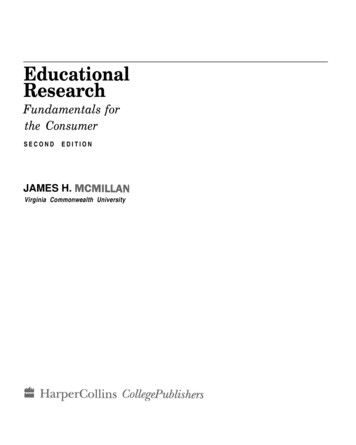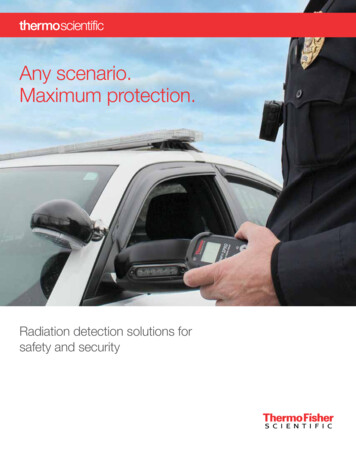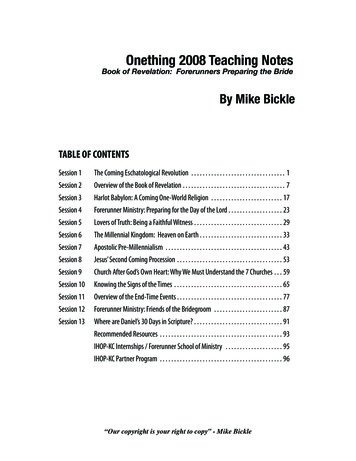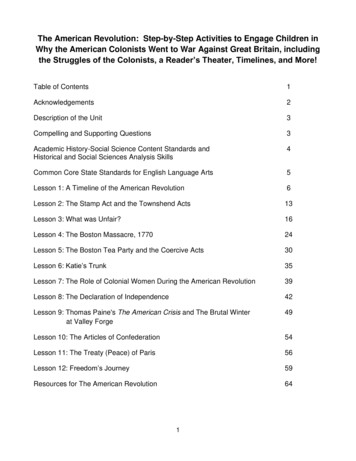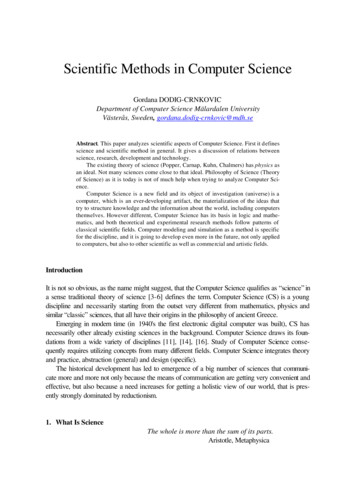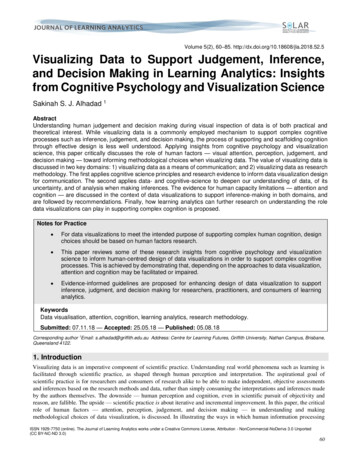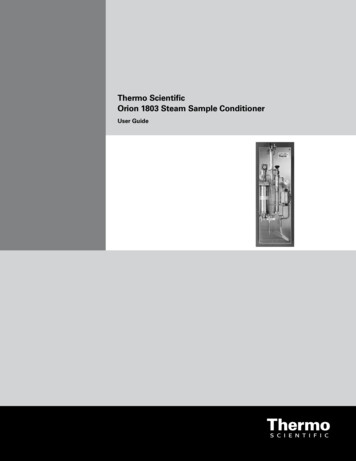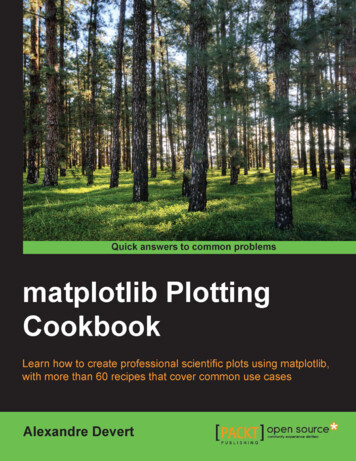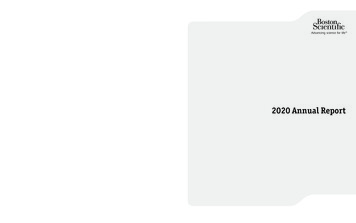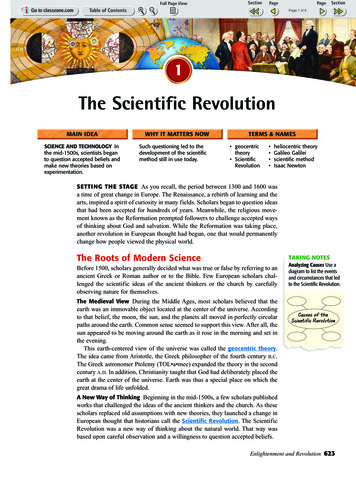
Transcription
Page 1 of 61The Scientific RevolutionMAIN IDEASCIENCE AND TECHNOLOGY Inthe mid-1500s, scientists beganto question accepted beliefs andmake new theories based onexperimentation.WHY IT MATTERS NOWSuch questioning led to thedevelopment of the scientificmethod still in use today.TERMS & NAMES geocentrictheory ScientificRevolution heliocentric theoryGalileo Galileiscientific methodIsaac NewtonSETTING THE STAGE As you recall, the period between 1300 and 1600 wasa time of great change in Europe. The Renaissance, a rebirth of learning and thearts, inspired a spirit of curiosity in many fields. Scholars began to question ideasthat had been accepted for hundreds of years. Meanwhile, the religious movement known as the Reformation prompted followers to challenge accepted waysof thinking about God and salvation. While the Reformation was taking place,another revolution in European thought had begun, one that would permanentlychange how people viewed the physical world.The Roots of Modern ScienceTAKING NOTESBefore 1500, scholars generally decided what was true or false by referring to anancient Greek or Roman author or to the Bible. Few European scholars challenged the scientific ideas of the ancient thinkers or the church by carefullyobserving nature for themselves.Analyzing Causes Use adiagram to list the eventsand circumstances that ledto the Scientific Revolution.The Medieval View During the Middle Ages, most scholars believed that theearth was an immovable object located at the center of the universe. Accordingto that belief, the moon, the sun, and the planets all moved in perfectly circularpaths around the earth. Common sense seemed to support this view. After all, thesun appeared to be moving around the earth as it rose in the morning and set inthe evening.This earth-centered view of the universe was called the geocentric theory.The idea came from Aristotle, the Greek philosopher of the fourth century B.C.The Greek astronomer Ptolemy (TOL a mee) expanded the theory in the secondcentury A.D. In addition, Christianity taught that God had deliberately placed theearth at the center of the universe. Earth was thus a special place on which thegreat drama of life unfolded.Causes of theScientific RevolutionA New Way of Thinking Beginning in the mid-1500s, a few scholars publishedworks that challenged the ideas of the ancient thinkers and the church. As thesescholars replaced old assumptions with new theories, they launched a change inEuropean thought that historians call the Scientific Revolution. The ScientificRevolution was a new way of thinking about the natural world. That way wasbased upon careful observation and a willingness to question accepted beliefs.Enlightenment and Revolution 623
Page 2 of 6A combination of discoveries and circumstances led to the Scientific Revolutionand helped spread its impact. During the Renaissance, European explorers traveledto Africa, Asia, and the Americas. Such lands were inhabited by peoples and animals previously unknown in Europe. These discoveries opened Europeans to thepossibility that there were new truths to be found. The invention of the printingpress during this period helped spread challenging ideas—both old and new—more widely among Europe’s thinkers.The age of European exploration also fueled a great deal of scientific research,especially in astronomy and mathematics. Navigators needed better instrumentsand geographic measurements, for example, to determine their location in the opensea. As scientists began to look more closely at the world around them, they madeobservations that did not match the ancient beliefs. They found they had reachedthe limit of the classical world’s knowledge. Yet, they still needed to know more.A Revolutionary Model of the UniverseAn early challenge to accepted scientific thinking came in the field of astronomy.It started when a small group of scholars began to question the geocentric theory.The Heliocentric Theory Although backed by authority and common sense, theSaturn This modelshows howCopernicus saw theplanets revolvingaround the sun.624 Chapter 22geocentric theory did not accurately explain the movements of the sun, moon, andplanets. This problem troubled a Polish cleric and astronomer named NicolausCopernicus (koh PUR nuh kuhs). Inthe early 1500s, Copernicus becameinterested in an old Greek idea that thesun stood at the center of the universe.After studying planetary movementsfor more than 25 years, Copernicusreasoned that indeed, the stars, theearth, and the other planets revolvedaround the sun.Copernicus’s heliocentric, or suncentered, theory still did not completely explain why the planetsorbited the way they did. He alsothe starsEarthVenusknew that most scholars and clergyMars Sun MercuryJupiterwould reject his theory because itcontradicted their religious views.Fearing ridicule or persecution, Copernicus did not publish his findings until 1543,the last year of his life. He received a copy of his book, On the Revolutions of theHeavenly Bodies, on his deathbed.While revolutionary, Copernicus’s book caused little stir at first. Over the nextcentury and a half, other scientists built on the foundations he had laid. A Danishastronomer, Tycho Brahe (TEE koh brah), carefully recorded the movements ofthe planets for many years. Brahe produced mountains of accurate data based onhis observations. However, it was left to his followers to make mathematicalsense of them.After Brahe’s death in 1601, his assistant, a brilliant mathematician namedJohannes Kepler, continued his work. After studying Brahe’s data, Kepler concludedthat certain mathematical laws govern planetary motion. One of these laws showedthat the planets revolve around the sun in elliptical orbits instead of circles, as waspreviously thought. Kepler’s laws showed that Copernicus’s basic ideas were true.They demonstrated mathematically that the planets revolve around the sun.RecognizingEffectsHow didKepler’s findingssupport the heliocentric theory?
Page 3 of 6Galileo’s Discoveries An Italian scientist named Galileo Galilei built on the newtheories about astronomy. As a young man, Galileo learned that a Dutch lens makerhad built an instrument that could enlarge far-off objects. Galileo built his owntelescope and used it to study the heavens in 1609.Then, in 1610, he published a small book called Starry Messenger, whichdescribed his astonishing observations. Galileo announced that Jupiter had fourmoons and that the sun had dark spots. He also noted that the earth’s moon had arough, uneven surface. This shattered Aristotle’s theory that the moon and starswere made of a pure, perfect substance. Galileo’s observations, as well as his lawsof motion, also clearly supported the theories of Copernicus.Conflict with the Church Galileo’s findings frightened both Catholic and Protes-tant leaders because they went against church teaching and authority. If peoplebelieved the church could be wrong about this, they could question other churchteachings as well.In 1616, the Catholic Church warned Galileo not to defend the ideas ofCopernicus. Although Galileo remained publicly silent, he continued his studies.Then, in 1632, he published Dialogue Concerning the Two Chief World Systems.This book presented the ideas of both Copernicus and Ptolemy, but it clearlyshowed that Galileo supported the Copernican theory. The pope angrily summonedGalileo to Rome to stand trial before the Inquisition.Galileo stood before the court in 1633. Under the threat of torture, he kneltbefore the cardinals and read aloud a signed confession. In it, he agreed that theideas of Copernicus were false.AnalyzingPrimary SourcesIn what twoways does Galileoseek to appeasethe Church?PRIMARY SOURCEWith sincere heart and unpretendedfaith I abjure, curse, and detest theaforesaid errors and heresies [ofCopernicus] and also every other error. . . contrary to the Holy Church, and Iswear that in the future I will neveragain say or assert . . . anything thatmight cause a similar suspiciontoward me.GALILEO GALILEI, quoted inThe DiscoverersGalileo was never again a freeman. He lived under house arrest anddied in 1642 at his villa near Florence.However, his books and ideas stillspread all over Europe. (In 1992, theCatholic Church officially acknowledged that Galileo had been right.)Galileo standsbefore the papalcourt. The Scientific MethodThe revolution in scientific thinking that Copernicus, Kepler, and Galileo beganeventually developed into a new approach to science called the scientific method.The scientific method is a logical procedure for gathering and testing ideas. It beginswith a problem or question arising from an observation. Scientists next form ahypothesis, or unproved assumption. The hypothesis is then tested in an experimentor on the basis of data. In the final step, scientists analyze and interpret their data toreach a new conclusion. That conclusion either confirms or disproves the hypothesis.Enlightenment and Revolution 625
Page 4 of 61609 Keplerpublishes first twolaws of planetarymotion.1566 Marie de CosteBlanche publishes TheNature of the Sun and Earth.152015701543 Copernicus publishesheliocentric theory.Vesalius publishes humananatomy textbook. NicolausCopernicus beganthe ScientificRevolution with hisheliocentric theory.1610 GalileopublishesStarryMessenger.16201590 Jansseninventsmicroscope.1620 Bacon’s bookNovum Organum (NewInstrument) encouragesexperimental method.Bacon and Descartes The scientific method did not develop overnight. The workof two important thinkers of the 1600s, Francis Bacon and René Descartes(day KAHRT), helped to advance the new approach.Francis Bacon, an English statesman and writer, had a passionate interest inscience. He believed that by better understanding the world, scientists would generate practical knowledge that would improve people’s lives. In his writings, Baconattacked medieval scholars for relying too heavily on the conclusions of Aristotle and other ancient thinkers. Instead of reasoning from abstract theories, heurged scientists to experiment and then draw conclusions. This approach is calledempiricism, or the experimental method.In France, René Descartes also took a keen interest in science. He developedanalytical geometry, which linked algebra and geometry. This provided an important new tool for scientific research.Like Bacon, Descartes believed that scientists needed to reject old assumptionsand teachings. As a mathematician, however, he approached gaining knowledge differently than Bacon. Rather than using experimentation, Descartes relied on mathematics and logic. He believed that everything should be doubted until proved byreason. The only thing he knew for certain was that he existed—because, as hewrote, “I think, therefore I am.” From this starting point, he followed a train of strictreasoning to arrive at other basic truths.Modern scientific methods are based on the ideas of Bacon and Descartes.Scientists have shown that observation and experimentation, together with generallaws that can be expressed mathematically, can lead people to a better understandingof the natural world.Newton Explains the Law of GravityBy the mid-1600s, the accomplishments of Copernicus, Kepler, and Galileo had shattered the old views of astronomy and physics. Later, the great English scientist IsaacNewton helped to bring together their breakthroughs under a single theory of motion.Changing Idea: Scientific MethodOld ScienceScholars generally relied on ancientauthorities, church teachings, commonsense, and reasoning to explain thephysical world.626 Chapter 22New ScienceIn time, scholars began to use observation,experimentation, and scientific reasoning togather knowledge and draw conclusionsabout the physical world.ContrastingHow didDescartes’sapproach to sciencediffer from Bacon’s?
Page 5 of 61628 Harveyreveals howhuman heartfunctions.1637 Descartes’s1662 Boyle discovers mathematicalbook Discourse onMethod sets forthhis scientific methodof reasoning fromthe basis of doubt.relationship between the pressure andvolume of gases, known as Boyle’s law.16201633 Galileofaces Inquisitionfor support ofCopernicus’stheory.ClarifyingWhy was thelaw of gravitationimportant?1674 Leeuwenhoek observesbacteria through .1670172016431666 France establishes1687 NewtonTorricelliinventsbarometer.Academy of Sciences.publishes lawof gravity.1660 England establishes RoyalSociety to support scientific study.Newton studied mathematics and physics at Cambridge University. By the timehe was 26, Newton was certain that all physical objects were affected equally by thesame forces. Newton’s great discovery was that the same force ruled motion of theplanets and all matter on earth and in space. The key idea that linked motion in theheavens with motion on the earth was the law of universal gravitation. Accordingto this law, every object in the universe attracts every other object. The degree ofattraction depends on the mass of the objects and the distance between them.In 1687, Newton published his ideas in a work called The MathematicalPrinciples of Natural Philosophy. It was one of the most important scientific booksever written. The universe he described was like a giant clock. Its parts all workedtogether perfectly in ways that could be expressed mathematically. Newtonbelieved that God was the creator of this orderly universe, the clockmaker who hadset everything in motion. Isaac Newton’slaw of gravityexplained how thesame physical lawsgoverned motionboth on earth andin the heavens.The Scientific Revolution SpreadsAs astronomers explored the secrets of the universe, other scientists began to studythe secrets of nature on earth. Careful observation and the use of the scientificmethod eventually became important in many different fields.Scientific Instruments Scientists developed new tools and instruments to makethe precise observations that the scientific method demanded. The first microscopewas invented by a Dutch maker of eyeglasses, Zacharias Janssen (YAHN suhn),in 1590. In the 1670s, a Dutch drapery merchant and amateur scientist namedAnton van Leeuwenhoek (LAY vuhn HUK) used a microscope to observe bacteriaswimming in tooth scrapings. He also examined red blood cells for the first time.In 1643, one of Galileo’s students, Evangelista Torricelli (TAWR uh CHEHL ee),developed the first mercury barometer, a tool for measuring atmospheric pressureand predicting weather. In 1714, the German physicist Gabriel Fahrenheit(FAR uhn HYT) made the first thermometer to use mercury in glass. Fahrenheit’sthermometer showed water freezing at 32 . A Swedish astronomer, Anders Celsius(SEHL see uhs), created another scale for the mercury thermometer in 1742.Celsius’s scale showed freezing at 0 .Medicine and the Human Body During the Middle Ages, European doctors hadaccepted as fact the writings of an ancient Greek physician named Galen. However,Galen had never dissected the body of a human being. Instead, he had studied theanatomy of pigs and other animals. Galen assumed that human anatomy was muchthe same. A Flemish physician named Andreas Vesalius proved Galen’s assumptionswrong. Vesalius dissected human corpses and published his observations. HisEnlightenment and Revolution 627
Page 6 of 6book, On the Structure of the Human Body(1543), was filled with detailed drawings ofhuman organs, bones, and muscle.In the late 1700s, British physicianEdward Jenner introduced a vaccine to prevent smallpox. Inoculation using live smallpox germs had been practiced in Asia forcenturies. While beneficial, this techniquecould also be dangerous. Jenner discoveredthat inoculation with germs from a cattle disease called cowpox gave permanent protection from smallpox for humans. Becausecowpox was a much milder disease, the risksfor this form of inoculation were muchlower. Jenner used cowpox to produce theworld’s first vaccination. The famousDutch painterRembrandt paintedAnatomy Lesson ofDr. Tulp in 1632from an actualanatomy lesson.The corpse was thatof a criminal.SECTIONVocabularyInoculation is theact of injecting agerm into a person’s body so as tocreate an immunityto the disease.Discoveries in Chemistry Robert Boyle pioneered the use of the scientific method inchemistry. He is considered the founder of modern chemistry. In a book called TheSceptical Chymist (1661), Boyle challenged Aristotle’s idea that the physical worldconsisted of four elements—earth, air, fire, and water. Instead, Boyle proposed thatmatter was made up of smaller primary particles that joined together in different ways.Boyle’s most famous contribution to chemistry is Boyle’s law. This law explains howthe volume, temperature, and pressure of gas affect each other.The notions of reason and order, which spurred so many breakthroughs in science, soon moved into other fields of life. Philosophers and scholars across Europebegan to rethink long-held beliefs about the human condition, most notably therights and liberties of ordinary citizens. These thinkers helped to usher in a movement that challenged the age-old relationship between a government and its people, and eventually changed forever the political landscape in numerous societies.1ASSESSMENTTERMS & NAMES 1. For each term or name, write a sentence explaining its significance. geocentric theory Scientific Revolution heliocentric theory Galileo Galilei scientific method Isaac NewtonUSING YOUR NOTESMAIN IDEASCRITICAL THINKING & WRITING2. Which event or circumstance3. Before the 1500s, who and6. DRAWING CONCLUSIONS “If I have seen farther thando you consider to be themost significant? Why?what were the final authoritieswith regard to most knowledge?4. How did the heliocentric theoryof the universe differ from thegeocentric theory?Causes of theScientific Revolution5. What are the main steps of thescientific method?others,” said Newton, “it is because I have stood on theshoulders of giants.” Could this be said of most scientificaccomplishments? Explain.7. ANALYZING MOTIVES Why might institutions of authoritytend to reject new ideas?8. FORMING AND SUPPORTING OPINIONS Do you agreewith Galileo’s actions during his Inquisition? Explain.9. WRITING ACTIVITY SCIENCE AND TECHNOLOGY Create atelevision script for a discovery of the Scientific Revolution.Include key people, ideas, and accomplishments.CONNECT TO TODAY CREATING A GRAPHICResearch a modern-day invention or new way of thinking and then describe it and its impacton society to the class in a poster or annotated diagram.628 Chapter 22
change how people viewed the physical world. The Roots of Modern Science Before 1500, scholars generally decided what was true or false by referring to an ancient Greek or Roman author or to the Bible. Few European scholars chal-lenged the scientific ideas of the ancient thinkers or
